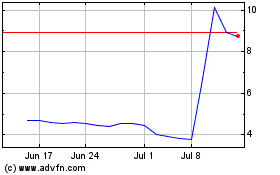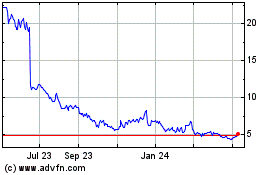uniQure N.V. (NASDAQ: QURE), a leading gene therapy company
advancing transformative therapies for patients with severe unmet
medical needs, today announced two publications of preclinical data
from its gene therapy candidate AMT-130 in Huntington’s disease, in
the journals Nucleic Acids Research and Molecular Therapy – Methods
& Clinical Development.
The first publication in Nucleic Acids Research
examines the tolerability and efficacy of non-selective huntingtin
protein (HTT) lowering using an AAV5 encoded micro-RNA targeting
human HTT (AAV5-miHTT) in the humanized Hu128/21 mouse model of
Huntington’s disease. The Hu128/21 model represents a genetically
accurate model of Huntington’s disease, as it expresses both the
mutant and wild type full-length human HTT transgene. The animals
received bilateral intrastriatal infusions by convection-enhanced
delivery of either the control dose, or three ascending doses at
the onset of the disease and were evaluated for 7 months, when
sacrifice occurred.
A dose-dependent suppression of full length HTT
(both wild-type and mutant) was observed 7 months after a single
injection of AAV5-miHTT, with reductions of 92% in the striatum and
64% in the frontal cortex. AAV5 also showed broad distribution at
all time points evaluated and was clearly observed in the striatum,
the hippocampus and the cortex. These data are consistent with
prior studies and further demonstrate that AAV5 undergoes
anterograde and retrograde axonal transport following infusion,
resulting in broad transduction of the structures affected by
Huntington’s disease. AAV5-miHTT resulted in both cognitive and
psychiatric improvements, as well as the prevention of neuronal
degeneration, indicating the potential therapeutic benefit of
non-selective HTT lowering. The authors concluded that the Hu128/21
model is not ideal for evaluating therapeutic changes in motor
performance as a result of inherently increasing obesity in the
mice that likely contributed to progressive motor deficits. The
authors did cite improved motor coordination in an R6/2 mouse model
that better demonstrates the characteristic weight loss associated
with Huntington’s disease.
Tolerability was evaluated using measures of
gliosis, brain morphology, body weight and survival. Results
demonstrated that non-selective knock down of HTT was safe and well
tolerated in the humanized mouse model, even in the absence of
background mouse wild-type HTT. Additionally, there were no lateral
ventricle size changes observed at any dose tested.
“The impact on many features of Huntington’s
disease with the AMT-130 gene therapy approach are encouraging and
support its continued assessment in patients with this debilitating
disease,” stated Michael R. Hayden, Killiam Professor of Medical
Genetics at the CMMT and the University of British Columbia, and
co-author of the study.
These findings were further supported by a
recently published study in Molecular Therapy - Methods &
Clinical Development, on neuronal and astrocytic cell cultures
derived from induced pluripotent stem cells (iPSCs) from two
Huntington’s disease patients with different CAG-repeat
lengths.
Results from this study demonstrated significant
non-selective reduction of up to 68% of human HTT in Huntington’s
disease patient-derived iPSC neurons and astrocytes, with no
observed toxicity or off-target effects in gene expression and
regulation.
“These results are very encouraging in the
context of AMT-130 as a potential gene therapy for Huntington’s
disease, where durable and potent suppression of huntingtin protein
is needed in the striatum and cortex,” stated Sander van Deventer,
M.D., Ph.D., EVP research and product development. “Moreover, these
studies examine for the first time the tolerability and efficacy of
non-selective human HTT lowering and demonstrate the approach is
well-tolerated, even in the absence of background wild-type
huntingtin protein. The data provide further support for the
potential safety and efficacy of AMT-130 and we remain excited to
advance our recently initiated Phase I/II clinical trial of AMT-130
in patients with Huntington’s disease.”
The publication, “Potent and sustained
huntingtin lowering via AAV5 encoding miRNA preserves striatal
volume and cognitive function in a humanized mouse model of
Huntington disease”, is available online in the journal Nucleic
Acids Research.
The publication, “AAV5-miHTT Lowers Huntingtin
mRNA and Protein without Off-Target Effects in Patient-Derived
Neuronal Cultures and Astrocytes”, is available online in journal
Molecular Therapy - Methods & Clinical Development.
About AMT-130AMT-130 is a gene
therapy product candidate consisting of an AAV5 vector carrying an
artificial micro-RNA specifically tailored to silence the
huntingtin gene, leveraging our proprietary miQURE™ silencing
technology. The therapeutic goal is to inhibit the production of
the mutant protein (mHTT). Using AAV vectors to deliver micro-RNAs
directly to the brain for non-selective knockdown of the huntingtin
gene represents a highly innovative and promising approach to
treating Huntington’s disease.
About Huntington’s
DiseaseHuntington’s disease is a rare, inherited
neurodegenerative disorder that leads to loss of muscle
coordination, behavioral abnormalities and cognitive decline,
resulting in complete physical and mental deterioration. The
disease is an autosomal dominant condition with a disease-causing
CAG repeat expansion in the first exon of the huntingtin gene, that
leads to the production and aggregation of abnormal protein in the
brain. Despite the clear etiology of Huntington’s disease, there
are no therapies to delay the onset or to slow the disease’s
progression.
About uniQure uniQure is
delivering on the promise of gene therapy – single treatments with
potentially curative results. We are leveraging our modular and
validated technology platform to rapidly advance a pipeline of
proprietary gene therapies to treat patients with hemophilia B,
hemophilia A, Huntington's disease, Fabry disease, spinocerebellar
ataxia Type 3 and other diseases. www.uniQure.com
uniQure Forward-Looking
StatementsThis press release contains forward-looking
statements. All statements other than statements of historical fact
are forward-looking statements, which are often indicated by terms
such as "anticipate," "believe," "could," "estimate," "expect,"
"goal," "intend," "look forward to", "may," "plan," "potential,"
"predict," "project," "should," "will," "would" and similar
expressions. Forward-looking statements are based on management's
beliefs and assumptions and on information available to management
only as of the date of this press release. These forward-looking
statements include, but are not limited to, whether AMT-130 may
prove to be clinically safe or efficacious or become a successful
treatment for patients suffering from Huntington’s disease. Our
actual results could differ materially from those anticipated in
these forward-looking statements for many reasons, including,
without limitation, risks associated with our and our
collaborators’ clinical development activities, clinical results,
collaboration arrangements, corporate reorganizations and strategic
shifts, regulatory oversight, product commercialization and
intellectual property claims, as well as the risks, uncertainties
and other factors described under the heading "Risk Factors" in
uniQure’s Quarterly Report on Form 10-Q filed on October 28, 2019.
Given these risks, uncertainties and other factors, you should not
place undue reliance on these forward-looking statements, and we
assume no obligation to update these forward-looking statements,
even if new information becomes available in the future.
|
uniQure Contacts: |
|
|
|
|
|
|
|
FOR INVESTORS: |
|
FOR MEDIA: |
|
|
|
|
|
Maria E. Cantor |
Eva M. Mulder |
Tom Malone |
|
Direct: 339-970-7536 |
Direct: +31 20 240 6103 |
Direct: 339-970-7558 |
|
Mobile: 617-680-9452 |
Mobile: +31 6 52 33 15 79 |
Mobile: 339-223-8541 |
|
m.cantor@uniQure.com |
e.mulder@uniQure.com |
t.malone@uniQure.com |
uniQure NV (NASDAQ:QURE)
Historical Stock Chart
From Mar 2024 to Apr 2024

uniQure NV (NASDAQ:QURE)
Historical Stock Chart
From Apr 2023 to Apr 2024
